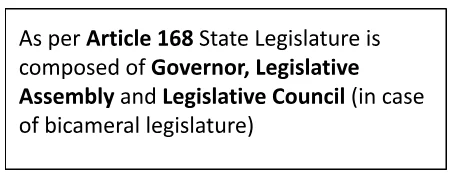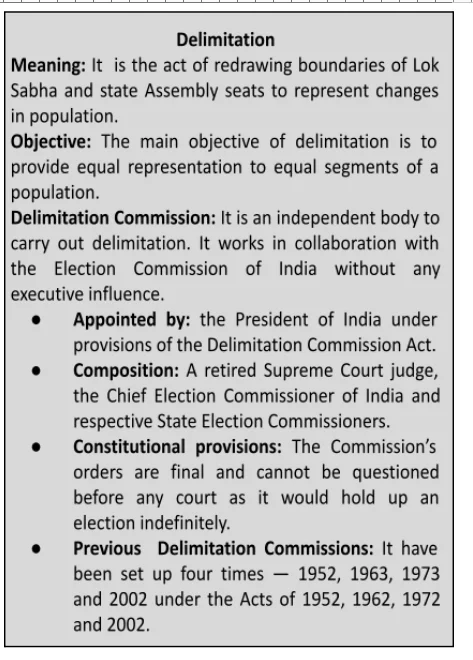The Constitution of India establishes a federal structure, dividing powers between the Central and State Governments. State Legislatures, detailed in Part VI and Articles 168 to 212 of the Constitution, form a crucial part of this federal framework. They address various aspects including organization, composition, and functions, ensuring effective governance at the state level.
Overview of Structure and Function of State Legislature in India
The Role and Structure of State Legislatures in India’s Federal System
- Federal Structure and Division of Powers: The Constitution of India gives us a federal structure where the powers between the Central Government and the State Government are divided.

- Integral Role of State Legislatures: So, the State Legislatures are an integral part of this federal structure, serving as the primary legislative bodies at the state level.
- Constitutional Provisions: Part VI and Articles 168 to 212 of the Constitution deal with the matters related to the State Legislature in India.
- Scope of State Legislature Provisions: It deals with the organisation, composition, duration, officers, procedures, privileges, powers and so on of the state legislature.
Bicameral and Unicameral Legislature
- Unicameral legislature: It refers to having only one legislative chamber (State Legislative Assembly), which performs all the functions like enacting laws, passing a budget, and discussing matters of national and international importance.
- Most of the states in India have a unicameral legislature except for six states.
- Bicameral legislature: The state having two separate law-making Houses (State Legislative Assembly + State Legislative Council) to perform the functions like passing the budget and enacting laws.
- India has a bicameral legislature at the Centre level, and only 6 States have a bicameral legislature.
- These States are Andhra Pradesh, Karnataka, Telangana, Maharashtra, Bihar, and Uttar Pradesh.
- No union territory has a legislative council. (As per Article 168)
- Note: The Tamil Nadu Legislative Council Act, 2010 to revive the legislative council in the State of Tamil Nadu is yet to be implemented.
Enroll now for UPSC Online Course
Creation and Abolition of State Legislative Council
- Constitutional Provision: The creation and abolition of the State Legislative Council is given in Article 169 of the Indian Constitution.
- Role of Parliament: The Parliament can abolish a legislative council (where it already exists) or create it (where it does not exist), if the legislative assembly of the concerned state passes a resolution to that effect.
- Special Majority: Such a specific resolution must be passed by the state assembly by a special majority, that is, a majority of the total membership of the assembly and a majority of not less than two-thirds of the members of the assembly present and voting.
- Legislative Process: This Act of Parliament is not to be deemed as an amendment of the Constitution for the purposes of Article 368 and is passed like an ordinary piece of legislation (ie, by simple majority).
- Criticism in Constituent Assembly: The idea of having a second chamber in the states was criticised in the Constituent Assembly on the grounds that it was not representative of the people, that it delayed the legislative process and that it was an expensive institution.
- Flexibility for States: Consequently the provision was made for the abolition or creation of a legislative council to enable a state to have a second chamber or not according to its own willingness and financial strength.
Composition of the State Legislature
- Configuration of Legislative Assemblies: Article 170 of the Indian Constitution talks about the configuration of the Legislative Assemblies. This Article simply put emphasis on what will be the structure of the Legislative Assemblies in the state.
- Configuration of Legislative Councils: On the other hand, the configuration of the Legislative Council is given in Article 171 of the Indian Constitution.
Composition of State Assembly (Vidhan Sabha)
- Strength: The Legislative Assembly of the state can have at most 500 constituencies and at least 60 constituencies.
- However, there are several exceptions to the composition of the Legislative Assembly. For example – Mizoram, Sikkim, and Goa which have less than 60 constituencies.
- Nomination: The Governor could nominate one member from the Anglo-Indian community to the Legislative Assembly of State under Article 333 till 2019.
- However, this was discontinued after the enactment of the 104th Constitutional Amendment Act, 2019.
- Election of the members:
- The Entire State is divided into several territorial constituencies by the Delimitation Commission.
- The representatives of the territorial constituencies are elected through the process of direct election.
- Territorial Constituencies:
- The constituencies are drawn in such a manner that the ratio between the population of each constituency and the number of seats allotted to it is the same throughout the state.
- Here, by the term “population”, we mean the latest population data which has been published in the preceding census.
- Readjustment after each census: The composition of the Legislative Assembly in any state can change according to the change in the population of that state.
- After each census, a readjustment is to be made in the:
- Total number of seats in the assembly of each state and
-
-
-
- The division of each state into territorial constituencies.
-
-
- Authority and Manner Determination by Parliament: The Parliament is empowered to determine the authority and the manner in which it is to be made.
- Accordingly, Parliament enacted the Delimitation Commission Acts in 1952, 1962, 1972, and 2002 for this purpose.
-
-
- 84th Amendment Act of 2001: had frozen the following things till the year 2026.
- Total Number of Seats: The total number of seats in the Legislative Assembly of each State as readjusted on the basis of the 1971 census.
- Division into Territorial Constituencies: The division of such State into territorial constituencies as may be readjusted on the basis of the 2001 census.
- 84th Amendment Act of 2001: had frozen the following things till the year 2026.
-
- Tenure of the Assembly: Mentioned in Article 172 of the Indian Constitution, the Legislative Assembly has a normal term of five years. Its tenure starts from the day of its first meeting.
- Authority to Dissolve the Assembly: However, the Governor is authorised to dissolve the assembly at any time (i.e., even before the completion of five years) under circumstances established by the law.
- Extension of Tenure: Its tenure can also be extended during the National Emergency.
- Maximum Extension Period: During the period of the National Emergency, the Parliament can extend the tenure of the Legislative Assembly for a period of a maximum one year.
- Also, this extension should not be more than six months after the proclamation has ceased to operate.
- Re-election After Emergency: This means that the assembly should be re-elected within six months after the revocation of the emergency.

State Legislative Council (Vidhan Parishad)
- Strength: The size of the State Legislative Council cannot be more than 1/3rd of the membership of the State Legislative Assembly.
- Minimum Size of the Legislative Council: Its size cannot be less than 40 members.
-
-
- Dependency on Assembly Size: The size of the council depends on the size of the assembly of the concerned state.
- Determination of Actual Strength: Here, it should be noted here that although the Constitution has fixed the maximum and the minimum limits, the actual strength of a Council is fixed by Parliament.
-
- Election of the members: Out of the total members of the Council, following methods are used to elect members:
| Total members elected | Elected By |
| 1/3rd of the total members | By the members of local bodies in the state like municipalities, district boards, etc. |
| 1/3rd of the total members | By the members of the legislative assembly of the state from amongst persons who are not members of the assembly. |
| 1/12 of the total members | By graduates of three years standing and residing within the state. |
| 1/12 of the total members | By teachers of three years standing in the state, not lower in standard than secondary school. |
| 1/6 of the total members | Nominated by the Governor from amongst persons who have a special knowledge or practical experience of literature, science, art, cooperative movement and social service. |
- Note: This composition of a legislative council (mentioned in Article 171) as laid down in the Constitution is tentative and not final.
- The Parliament is authorised to modify or replace the same.
- However, it has not enacted any such law so far.
- Tenure of the Council: The legislative council is a continuing chamber, same as that of Rajya Sabha. It is a permanent body and is not subject to dissolution.
-
- 1/3rd of its members retire on the expiration of every second year. So, a member continues as such for six years.
- The tenure of six years is defined in Section 156 of The Representation of People Act, 1951 and not in the Constitution
- The vacant seats are filled up by fresh elections and nominations (by Governor) at the beginning of every third year.
- The retiring members are also eligible for re-election and re-nomination any number of times.
- 1/3rd of its members retire on the expiration of every second year. So, a member continues as such for six years.
Enroll now for UPSC Online Course
| Must Read | |
| Current Affairs | Editorial Analysis |
| Upsc Notes | Upsc Blogs |
| NCERT Notes | Free Main Answer Writing |
Conclusion
State Legislatures play a vital role in India’s federal system by enacting laws, scrutinizing the government, and representing the people at the state level.
- Their structure, whether unicameral or bicameral, and the defined processes for creation, abolition, and functioning, ensure that they adapt to the diverse needs of different states, maintaining the balance of power within the country.
Sign up for the PWOnlyIAS Online Course by Physics Wallah and start your journey to IAS success today!
| Related Articles | |
| National Emergency, The Dark Age of Indian Democracy | State Legislature in India |
| Indian Federal System | Making Of The Indian Constitution |

 GS Foundation
GS Foundation Optional Course
Optional Course Combo Courses
Combo Courses Degree Program
Degree Program












